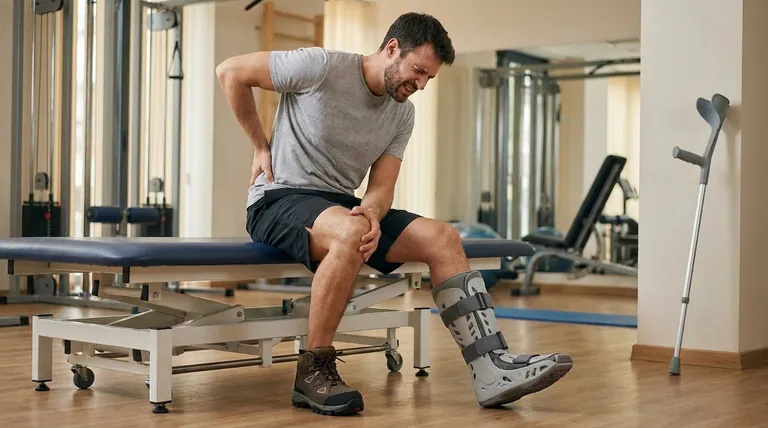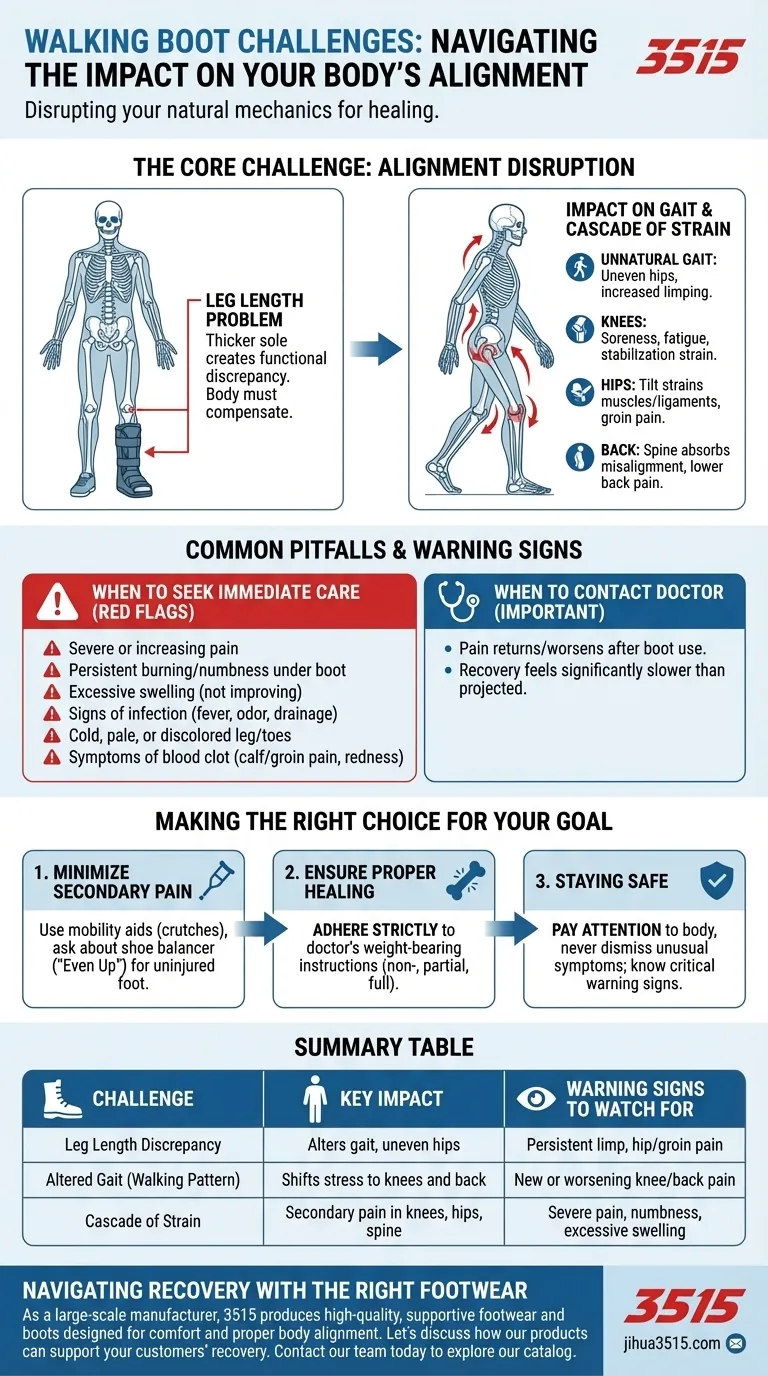While a walking boot is a critical tool for healing, its primary challenge is that it disrupts your body's natural alignment. The boot's height creates an imbalance between your legs, altering how you walk and placing new, unnatural stress on your knees, hips, and back, which can lead to secondary pain and discomfort.
The fundamental challenge of a walking boot isn't the boot itself, but the chain reaction it creates. By immobilizing one joint, it forces others—from your knee to your spine—to compensate, often resulting in new aches and pains that can complicate your recovery.

The Core Challenge: Disrupting Your Body's Alignment
A walking boot is designed to protect your injury, but it does so by changing your body's mechanics. Understanding this is the first step to managing the experience effectively.
The Leg Length Problem
The sole of a walking boot is almost always thicker than that of a regular shoe. This difference in height, even if it's just an inch, creates a functional leg length discrepancy.
Your body is a finely tuned machine built for symmetry. When one leg is suddenly "longer" than the other, your entire posture must adjust to compensate with every step.
The Impact on Your Gait
This imbalance forces you into an unnatural walking pattern, or gait. Your hips will become uneven, causing you to limp or rock from side to side more than you would with a simple injury.
This altered gait changes how forces travel through your body, shifting the load away from your injured foot and onto other joints that aren't prepared for the extra work.
A Cascade of Strain
This compensation is not without consequences. The strain travels up your body, often creating a cascade of new issues.
- Knees: The knee on both the injured and uninjured side can become sore. It may fatigue quickly as it works to stabilize your unbalanced movement.
- Hips: Your hips tilt to accommodate the height difference, which can strain the surrounding muscles and ligaments, often leading to hip or groin pain.
- Back: The spine absorbs the misalignment from the hips, which commonly results in new or worsened lower back pain.
Common Pitfalls and Warning Signs
While secondary joint pain is common, certain symptoms are red flags that require professional medical attention. Ignoring them can turn a manageable issue into a serious complication.
When to Seek Immediate Care
Do not wait to contact a medical professional if you experience any of the following:
- Severe or rapidly increasing pain.
- A persistent burning, stinging, or numb sensation under the boot.
- Excessive swelling that doesn't improve with elevation.
- Any signs of infection, such as fever, drainage, or a bad odor from the boot.
- Your leg or toes becoming cold, pale, or discolored.
- Symptoms of a blood clot, including localized pain, redness, and swelling in your calf or groin.
When to Contact Your Doctor
You should also follow up with your doctor for less urgent but still important issues:
- Pain that returns or gets worse after you have stopped using the boot.
- A recovery that feels significantly slower than your doctor initially projected.
Making the Right Choice for Your Goal
Successfully navigating your recovery involves being proactive about managing these challenges. Your approach should be tailored to your primary concern.
- If your primary focus is minimizing secondary pain: Consider using mobility aids like crutches to reduce strain, and ask your doctor about a shoe balancer (an "Even Up") for your uninjured foot to level your hips.
- If your primary focus is ensuring proper healing: Adhere strictly to your doctor's instructions on weight-bearing, which may progress from non-weight bearing to partial and finally full weight-bearing.
- If your primary focus is staying safe: Pay close attention to your body and never dismiss unusual symptoms; knowing the critical warning signs is your best defense against complications.
By anticipating these challenges, you can take control of your recovery and prevent minor issues from becoming major setbacks.
Summary Table:
| Challenge | Key Impact | Warning Signs to Watch For |
|---|---|---|
| Leg Length Discrepancy | Alters gait, uneven hips | Persistent limp, hip/groin pain |
| Altered Gait (Walking Pattern) | Shifts stress to knees and back | New or worsening knee/back pain |
| Cascade of Strain | Secondary pain in knees, hips, spine | Severe pain, numbness, excessive swelling |
Navigating recovery can be challenging, but the right footwear makes all the difference.
As a large-scale manufacturer, 3515 produces a comprehensive range of high-quality, supportive footwear and boots designed for comfort and proper body alignment. Whether you are a distributor, brand owner, or bulk client, our production capabilities ensure you have access to footwear that supports wellness and mobility.
Let's discuss how our products can support your customers' recovery journeys. Contact our team today to explore our catalog and find the perfect solution for your needs.
Visual Guide

Related Products
- Safety Footwear Wholesale Manufacturer for Custom OEM/ODM Production
- Premium Grain Leather Safety Boots for Bulk Supply
- Wholesale Safety Footwear Manufacturer for Bulk & Custom OEM Orders
- Customizable Anti-Smash Safety Boots for Wholesale & Private Label Manufacturing
- Premium Wholesale Wheat Nubuck Safety Boot with Rapid Lacing System
People Also Ask
- Is safety-toe as good as steel toe? Choose the Right Protection for Your Job
- How long can you wear safety boots? The Lifespan is Determined by Wear, Not Time
- What are OSHA approved shoes? Understanding the Correct Standards for Workplace Safety
- How do safety shoes contribute to cost savings for companies? A Strategic Investment in Risk and Cost Management
- What are the cultural perspectives on wearing shoes in the house? A Guide to Home Etiquette & Hygiene



















